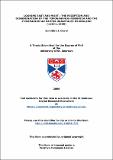Files in this item
Looking East and West : the reception and dissemination of the Topographia Hibernica and the Itinerarium ad partes Orientales in England [1185-c.1500]
Item metadata
| dc.contributor.advisor | Bartlett, Robert | |
| dc.contributor.author | David, Sumithra J. | |
| dc.date.accessioned | 2009-07-08T14:17:17Z | |
| dc.date.available | 2009-07-08T14:17:17Z | |
| dc.date.issued | 2009-06-25 | |
| dc.identifier.uri | https://hdl.handle.net/10023/725 | |
| dc.description.abstract | In this study the manuscript transmission, dissemination and reception of Gerald of Wales’ Topographia Hibernica (TH) and William of Rubruck’s Itinerarium ad partes Orientales (Itinerary) in England c.1185-1500 have been explored. The TH and the Itinerary are well known texts and have been carefully examined by modern scholars. Nevertheless, the afterlives of these two medieval texts have largely been neglected. Similarities in the authors’ approach and interests alongside the obvious difference in subject matter, i.e. the focus on two opposing ends of the believed peripheries of the world, have made the two texts worthy of consideration together. In chapters I and II, the extant manuscripts of each text have been been examined. As a consequence, the list of extant TH manuscripts, as provided by Robert Bartlett and Catherine Rooney, has been supplemented with two additional medieval manuscripts. The number of known medieval manuscripts of the Itinerary has also increased with the inclusion of one previously thought lost. In addition, through the examination of the manuscripts, the surviving attestations from catalogues and correspondence and through the subsequent re-use of the texts within other medieval narratives, this study offers a geographical and literary mapping of the dissemination of both works. It also examines the various uses to which the TH and the Itinerary were put, highlighting in particular the political significance of each text. Furthermore, in chapter III the contents of each manuscript containing the TH or the Itinerary are considered in order to explore the significance, if any, of the accompanying texts. The study culminates in chapter IV with an examination of three medieval bibliophiles: Simon Bozoun, John Erghome and John Gunthorpe, whose association with one or other of the text have offered a further contextualisation of the interest in the text, particularly in relation to their wider book collections. An approach which considers the text’s afterlife contextualises the work within its literary and socio-cultural milieus offering a wealth of information. By examining the availability of, and to a lesser extent the uses of, information regarding the Irish and the Mongols in England through these two specific texts, this study also hopes to help enhance our understanding of English attitudes to the two geographical extremities of the known medieval world. | en |
| dc.format.extent | 5472020 bytes | |
| dc.format.mimetype | application/pdf | |
| dc.language.iso | en | en |
| dc.publisher | University of St Andrews | |
| dc.rights | Creative Commons Attribution-NonCommercial-NoDerivs 3.0 Unported | |
| dc.rights.uri | http://creativecommons.org/licenses/by-nc-nd/3.0/ | |
| dc.subject | Medieval manuscripts | en |
| dc.subject.lcc | Z106.5G72E54D2 | en_US |
| dc.subject.lcsh | Manuscripts, Medieval--England--History--To 1500 | en_US |
| dc.subject.lcsh | Transmission of texts--England--History--To 1500 | en_US |
| dc.subject.lcsh | Giraldus, Cambrensis, 1146-1223. Topographia Hibernica | en_US |
| dc.subject.lcsh | Guilelmus de Ruysbroek, ca. 1210-ca. 1270. Itinerarium ad partes Orientales | en_US |
| dc.title | Looking East and West : the reception and dissemination of the Topographia Hibernica and the Itinerarium ad partes Orientales in England [1185-c.1500] | en |
| dc.type | Thesis | en |
| dc.type.qualificationlevel | Doctoral | en |
| dc.type.qualificationname | PhD Doctor of Philosophy | en |
| dc.publisher.institution | The University of St Andrews | en |
This item appears in the following Collection(s)
Except where otherwise noted within the work, this item's licence for re-use is described as Creative Commons Attribution-NonCommercial-NoDerivs 3.0 Unported
Items in the St Andrews Research Repository are protected by copyright, with all rights reserved, unless otherwise indicated.


